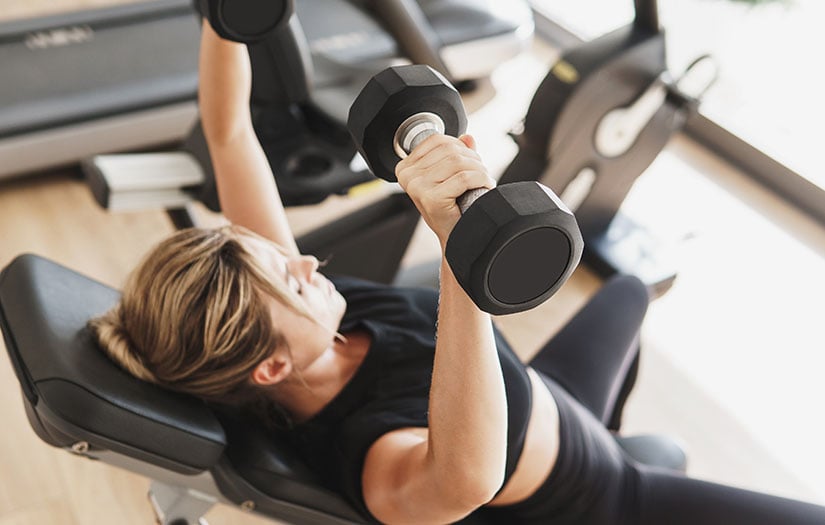The Physical Activity Guidelines for Americans recommend at least 150 minutes of moderate-intensity aerobic exercise, and at least 2 days of full-body resistance training per week. What counts as resistance training and how can you get started today? Read on to find out!
What is Resistance Training?
Resistance training is a form of exercise that increases muscular strength and endurance by exercising a muscle or muscle group against external resistance. Resistance training can be performed by using bodyweight exercises, like push-ups or squats, or with exercises that use equipment like bands, dumbbells, kettlebells, barbells, etc.
General Resistance Training Concepts
Muscular Adaptations
It’s important to know what your goals are when it comes to resistance training. Why? Your body will adapt to the type of training that you do. If your goal is to improve your balance, but you only focus on building strength, you might not see the results that you were hoping for. It’s best to plan your workouts around the results that you’d like to see.
Here are the main adaptations:
• Stabilization: Developing good stability around the joints and sufficient muscular endurance to produce good movement with a healthy range of motion.
• Muscular Endurance: The ability to produce and maintain force production for prolonged periods of time.
• Hypertrophy: Increased muscle size.
• Strength: The ability of the muscles to overcome external force, often using increasingly heavy loads.
• Power: The ability to produce the greatest possible force in the shortest amount of time (explosive movement!).
It’s not necessary to achieve each one of these goals, although there are benefits to each.
Acute Variables
With resistance training, you can modify what is called the acute variables (sets, reps, tempo, rest, and intensity) to work toward any one of those adaptations. Here are the acute variables used for each muscular adaptation:
Stabilization (Phase 1: Stabilization Endurance Training)
| Sets | Reps | Tempo | Rest | Intensity |
| 1-3 | 12-20 | Slow | 0-90 Sec | 12-20RM (Rep Max) |
Muscular Endurance (Phase 2: Strength Endurance Training)
| Sets | Reps | Tempo | Rest | Intensity |
| 2-4 |
8-12 (Strength) 8-12 (Stability) |
Moderate Slow |
0-60 sec after each superset | 8-12RM |
*Note: This phase uses supersets with the first exercise being a strength exercise, and the second being a biomechanically similar stability exercise.
Hypertrophy (Phase 3: Muscular Development Training)
| Sets | Reps | Tempo | Rest | Intensity |
| 3-6 | 6-12 | Moderate | 0-60 sec | N/A |
Strength (Phase 4: Maximal Strength Training)
| Sets | Reps | Tempo | Rest | Intensity |
| 4-6 | 1-5 | Explosive | 2-4 Min | 1-5RM |
Power (Phase 5: Power)
| Sets | Reps | Tempo | Rest | Intensity |
| 3-5 |
1-5 (Strength) 8-10 (Power) |
Explosive | 1-2 min between pairs; 3-5 minutes between circuits | 1-5RM, 8-10RM, or 30-45% of 1RM |
*Note: This phase uses supersets with the first exercise being a heavy strength exercise, and the second being a biomechanically similar power exercise using lighter weight.
Progressive Training
Even if your goal is to increase your muscle size (aka: hypertrophy), it’s important to work your way toward that more advanced type of training. At NASM, we use the OPT Model to appropriately progress through each phase to maximize results and minimize the risk of injury or over-training. Think of the model as building blocks. Certain foundational blocks must be built well before progressing, or the house might fall, so to speak.
Start Here: Everyone will start at Phase 1: Stabilization Endurance Training, regardless of their level of experience, to build a solid foundation of good movement, joint stability, and form.
Next Step: Phase 2, Strength Endurance Training. This is the bridge between stabilization and strength – a critical phase to help you progress toward any strength or muscle development goal.
Once you’ve performed 4-6 weeks of Phase 1 and 2 training, you can choose to cycle back to Phase 1 and start over, or try one of the more advanced styles of training:
Optional Next Step: Phase 3: Muscle Development Training. If your goal is to build muscle mass, this is the phase for you!
Optional Next Step: Phase 4: Maximal Strength Training. If you want to lift heavy and build strength, you’ll enjoy this phase!
Optional Next Step: Phase 5: Power Training. If you’re an athlete or you enjoy doing explosive movements, Power Training has your name all over it.
Once you complete 4-6 weeks of training in each of your desired phases, you can cycle back through and continue to progress! Shameless plug: hiring a NASM-Certified Personal Trainer can help you continue to boost your results and reach your goals.
Training Frequency
Beginners should train 2-3 times per week, intermediate exercisers can train 3 days full-body or 4-days using a split routine, and advanced lifters can train 4-6 times/week (including multiple sessions per day) with appropriate splits to avoid over-training.
Types of Resistance Training
Resistance training doesn’t require fancy equipment or an expensive gym membership. You can easily perform resistance training exercises using your body weight, or you can use equipment like bands, machines, dumbbells, barbells, kettlebells, sandbags, and even at-home equipment (bags of flour in a backpack, etc.), to name a few!
Resistance Training Exercise Examples
Here are some great exercises to incorporate into your training routine (click on the links for exercise demos and instructions):
Chest/triceps
- Bench Press (can perform the same movement, but with dumbbells if needed):
- Cable Crossover (can be performed using resistance bands):
Back/biceps
• Standing Row (can be performed using bands or cable machines):
• Bent Over Row (can be performed using dumbbells, barbell, sandbag, bands):
• Face Pull (can be performed using cable machines or resistance bands):
Legs
• Goblet Squat (can be performed bodyweight, or by holding a weighted object):
• Step-up to Balance (can be performed bodyweight, or with added resistance):
• Reverse Lunge to Balance (can be performed with or without weight):
Glutes and Hamstrings
• Floor bridge (can be performed using bodyweight or added weight or resistance band across the hips):
• Deadlift (can be performed with kettlebell or other weighted object):
• Romanian Deadlift (can be performed with dumbbells, sandbag, barbell, or kettlebell):
Shoulders
• Scaption:
• Incline Chest Press (can be performed with dumbbells or barbell):
Sample Resistance Training Workout
For this Phase 1 resistance workout, choose an exercise from the list above to fit each category (example: choose 1 chest/triceps exercise, 1 leg exercise, etc., until you have one from each category for a full-body workout), and perform each exercise in a row, circuit-style. When you’ve gone through the circuit once, you can rest 0-90 seconds before performing up to 3 sets of the circuit.
| Exercise | Sets | Reps | Tempo | Rest | Intensity |
|
1. Chest/Triceps 2. Legs 3. Back/Biceps 4. Glutes and Hamstrings 5. Shoulders |
1-3 | 12-20 | Slow | 0-90 Sec | 12-20RM (Rep Max) |
Note: It’s always important to perform a warm-up by foam rolling and stretching overactive muscles prior to your workout for best results!
The Biggest Benefits of Resistance Training
Need additional reasons to convince you that resistance training is worth the time and effort? Check out some of the benefits:
• Improved cardiovascular efficiency
• Improved hormone and cholesterol adaptations
• Increased muscle size
• Increased bone density
• Increased metabolism
• Decreased body fat
• Increased coordination
• Increased tendon and ligament strength
• Increased muscular endurance, strength, and power
Yes, please!
Can You Do Resistance Training at Home?
If the pandemic taught us one thing about fitness, it was that we CAN stay fit or get fit with resistance training at home! Because resistance training can be done using only body weight, it can be done anywhere, at any time. If you want to have some equipment, a pair of dumbbells and some resistance bands can be a great start to a consistent home workout routine.
Does Resistance Training Work Well for Weight Loss?
Short answer: Yes! The main benefit of resistance training for weight loss is that resistance training will help you increase the amount of muscle that you have. This is a huge bonus because muscle mass can drive up your daily caloric burn, meaning that you will burn more calories doing everyday activities as a result! Muscles for the win!
Is Resistance Training Good for Beginners?
Anyone at any fitness level can perform resistance training. It’s all about finding the right exercise variations and the proper resistance that allow you to perform all of the reps with good form, while still feeling slightly challenged.
What are you waiting for? Give it a try!
Reference:
Sutton, B. G. (Ed.). (2022). Resistance training concepts. In NASM Essentials of Personal Fitness Training, 7th Edition (pp. 609-622). Jones & Bartlett Learning.












